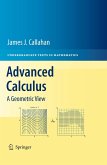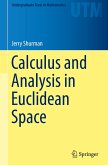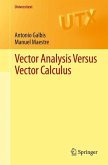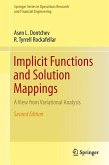A half-century ago, advanced calculus was a well-de?ned subject at the core of the undergraduate mathematics curriulum. The classic texts of Taylor [19], Buck [1], Widder [21], and Kaplan [9], for example, show some of the ways it was approached. Over time, certain aspects of the course came to be seen as more signi?cant-those seen as giving a rigorous foundation to calculus-and they - came the basis for a new course, an introduction to real analysis, that eventually supplanted advanced calculus in the core. Advanced calculus did not, in the process, become less important, but its role in the curriculum changed. In fact, a bifurcation occurred. In one direction we got c- culus on n-manifolds, a course beyond the practical reach of many undergraduates; in the other, we got calculus in two and three dimensions but still with the theorems of Stokes and Gauss as the goal. The latter course is intended for everyone who has had a year-long introduction to calculus; it often has a name like Calculus III. In my experience, though, it does not manage to accomplish what the old advancedcalculus course did. Multivariable calculusnaturallysplits intothreeparts:(1)severalfunctionsofonevariable,(2)one function of several variables, and (3) several functions of several variables. The ?rst two are well-developed in Calculus III, but the third is really too large and varied to be treated satisfactorily in the time remaining at the end of a semester. To put it another way: Green's theorem ?ts comfortably; Stokes' and Gauss' do not.
From the reviews:
"Many concepts in calculus and linear algebra have obvious geometric interpretations. ... This book differs from other advanced calculus works ... it can serve as a useful reference for professors. ... it is the adopted course resource, its inclusion in a college library's collection should be determined by the size and interests of the mathematics faculty. Summing Up ... . Upper-division undergraduate through professional collections." (C. Bauer, Choice, Vol. 48 (8), April, 2011)
"The author of this book sees an opportunity to bring back a more geometric, visual and physically-motivated approach to the subject. ... The author makes exceptionally good use of two and three-dimensional graphics. Drawings and figures are abundant and strongly support his exposition. Exercises are plentiful and they cover a range from routine computational work to proofs and extensions of results from the text. ... Strong students ... are likely to be attracted by the approach and the serious meaty content." (William J. Satzer, The Mathematical Association of America, January, 2011)
"A new geometric and visual approach to advanced calculus is presented. ... The book can be useful a textbook for beginners as well as a source of supplementary material for university teachers in calculus and analysis. ... the book meets a wide auditorium among undergraduate and graduate students in mathematics, physics, economics and in other fields which essentially use mathematical models. It is also very interesting for teachers and instructors in Calculus and Mathematical Analysis." (Sergei V. Rogosin, Zentralblatt MATH, Vol. 1205, 2011)
"Many concepts in calculus and linear algebra have obvious geometric interpretations. ... This book differs from other advanced calculus works ... it can serve as a useful reference for professors. ... it is the adopted course resource, its inclusion in a college library's collection should be determined by the size and interests of the mathematics faculty. Summing Up ... . Upper-division undergraduate through professional collections." (C. Bauer, Choice, Vol. 48 (8), April, 2011)
"The author of this book sees an opportunity to bring back a more geometric, visual and physically-motivated approach to the subject. ... The author makes exceptionally good use of two and three-dimensional graphics. Drawings and figures are abundant and strongly support his exposition. Exercises are plentiful and they cover a range from routine computational work to proofs and extensions of results from the text. ... Strong students ... are likely to be attracted by the approach and the serious meaty content." (William J. Satzer, The Mathematical Association of America, January, 2011)
"A new geometric and visual approach to advanced calculus is presented. ... The book can be useful a textbook for beginners as well as a source of supplementary material for university teachers in calculus and analysis. ... the book meets a wide auditorium among undergraduate and graduate students in mathematics, physics, economics and in other fields which essentially use mathematical models. It is also very interesting for teachers and instructors in Calculus and Mathematical Analysis." (Sergei V. Rogosin, Zentralblatt MATH, Vol. 1205, 2011)








